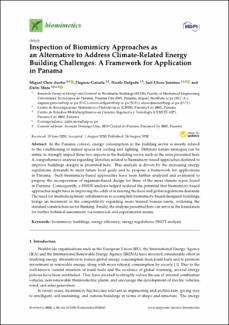Mostrar el registro sencillo del ítem
Inspection of Biomimicry Approaches as an Alternative to Address Climate-Related Energy Building Challenges: A Framework for Application in Panama
| dc.contributor.author | Chen Austin, Miguel | |
| dc.contributor.author | Garzola, Dagmar | |
| dc.contributor.author | Delgado, Nicole | |
| dc.contributor.author | Jiménez, José Ulises | |
| dc.contributor.author | Mora, Dafni | |
| dc.date.accessioned | 2021-04-18T15:55:55Z | |
| dc.date.available | 2021-04-18T15:55:55Z | |
| dc.date.issued | 2020-06-01 | |
| dc.identifier.uri | https://ridda2.utp.ac.pa/handle/123456789/11992 | |
| dc.description | In the Panama context, energy consumption in the building sector is mostly related to the conditioning of indoor spaces for cooling and lighting. Different nature strategies can be mimic to strongly impact these two aspects in the building sector, such as the ones presented here. A comprehensive analysis regarding literature related to biomimicry-based approaches destined to improve buildings designs is presented here. This analysis is driven by the increasing energy regulations demands to meet future local goals and to propose a framework for applications in Panama. Such biomimicry-based approaches have been further analyzed and evaluated to propose the incorporation of organism-based design for three of the most climate types found in Panama. Consequently, a SWOT analysis helped realized the potential that biomimicry-based approaches might have in improving the odds of in meeting the local and global regulations demands. The need for multidisciplinary collaboration to accomplish biomimicry-based-designed buildings, brings an increment in the competitivity regarding more trained human-assets, widening the standard-construction-sector thinking. Finally, the analysis presented here can serve as the foundation for further technical assessment, via numerical and experimental means | en_US |
| dc.description.abstract | In the Panama context, energy consumption in the building sector is mostly related to the conditioning of indoor spaces for cooling and lighting. Different nature strategies can be mimic to strongly impact these two aspects in the building sector, such as the ones presented here. A comprehensive analysis regarding literature related to biomimicry-based approaches destined to improve buildings designs is presented here. This analysis is driven by the increasing energy regulations demands to meet future local goals and to propose a framework for applications in Panama. Such biomimicry-based approaches have been further analyzed and evaluated to propose the incorporation of organism-based design for three of the most climate types found in Panama. Consequently, a SWOT analysis helped realized the potential that biomimicry-based approaches might have in improving the odds of in meeting the local and global regulations demands. The need for multidisciplinary collaboration to accomplish biomimicry-based-designed buildings, brings an increment in the competitivity regarding more trained human-assets, widening the standard-construction-sector thinking. Finally, the analysis presented here can serve as the foundation for further technical assessment, via numerical and experimental means | en_US |
| dc.format | application/pdf | en_US |
| dc.language | eng | |
| dc.language.iso | eng | en_US |
| dc.rights | info:eu-repo/semantics/openAccess | en_US |
| dc.rights | https://creativecommons.org/licenses/by-nc-sa/4.0 | en_US |
| dc.rights | https://creativecommons.org/licenses/by-nc-sa/4.0/ | |
| dc.rights | info:eu-repo/semantics/openAccess | |
| dc.subject | biomimicry | en_US |
| dc.subject | buildings | en_US |
| dc.subject | energy efficiency | en_US |
| dc.subject | energy regulations | en_US |
| dc.subject | SWOT analysis | en_US |
| dc.subject | biomimicry | |
| dc.subject | buildings | |
| dc.subject | energy efficiency | |
| dc.subject | energy regulations | |
| dc.subject | SWOT analysis | |
| dc.title | Inspection of Biomimicry Approaches as an Alternative to Address Climate-Related Energy Building Challenges: A Framework for Application in Panama | en_US |
| dc.type | info:eu-repo/semantics/article | en_US |
| dc.type | info:eu-repo/semantics/publishedVersion | en_US |
| dc.type | info:eu-repo/semantics/article | |
| dc.type | info:eu-repo/semantics/publishedVersion |
